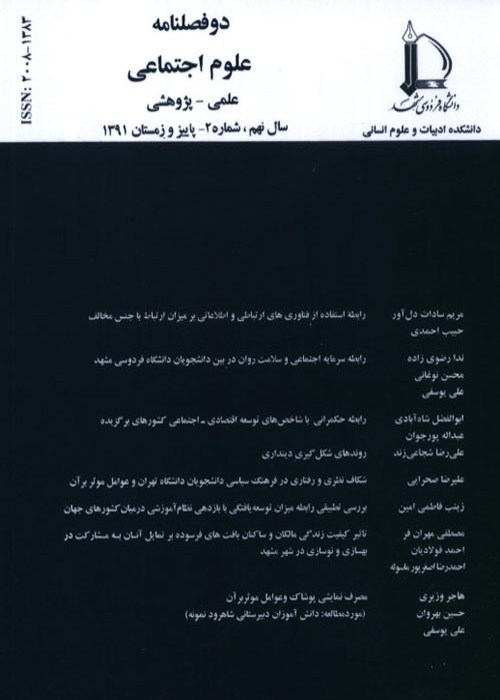Consumption of spiritual goods, a way to develop cultural capital: An inquiry on the New Age spiritualities in Iran
Author(s):
Article Type:
Research/Original Article (دارای رتبه معتبر)
Abstract:
1. Introduction
The New Age spiritualities and their popularity in Iran have drawn the attention of many scholars during the past few years. From the mid-1990s, some signs of spiritual phenomena appeared in Iran whose roots might be traced to the movements of the second half of the twentieth century, especially in Western industrial societies, which were called the "New Age spirituality". This wave spread rapidly in Iran, several books were published in Persian, several conferences were organized, and the communities emerged. Using a descriptive-analytical approach, the present paper is interested in the lifestyle of people in Tehran who participate in the communities of New Age spiritualties, seeking a way of living in which they will be able to combine spiritual practices with prosperity, success, and perfection. We examine the social class, cultural status and activities, and the lifestyle of the members of two communities, one based on a psychological approach and the other one mystical. The aim of this paper is to analyze how social origin and lifestyle of members weigh in motivation for joining these communities.
2. Theoretical Framework
A key feature of "New Age spiritualties" is a syncretic approach to the beliefs and practices from a range of resources, such as traditional religions, mysticism, esotericism, metaphysics, oriental disciplines and practices, holistic medicine and alternative medicine, psychotherapy and parapsychology, self-help and motivational psychology, techniques of "personal development", and even quantum physics ( Drury, 2004; Flere & Kirbis, 2009; Heelas, 1996; Heelas & Woodhead, 2005; Hérvieu-Leger, 1993, 2001; Houtman & Aupers, 2007 Rindfleish, 2005 ).Various studies have discussed the characteristics of the members of the communities of New Age from different aspects of life in different societies (Flere & Kirbis, 2009; Hanegraaff, 2005; Heelas, 1996; Laliberté, 2009; Rindfleish, 2005; Sutcliffe, 2006). Some of these studies have also pointed to the association between increasing the consumerism and tendency toward different forms of the New Age spiritualties. In the domain of sociology of consumption and lifestyle, we lean toward Pierre Bourdieu’s theory for studying social reproduction among the middle class in Iran and the ways in which cultural capital is developed, as a factor for achieving social distinction (Bourdieu, 1985).
3. Methodology
This analysis is based on the study of two women communities of New Age spiritualties in Tehran: one with a psychological approach (Hasty , specialized in the field of “personal development”) and the other one with a mystical approach (interpretation of the poems of Rumi and the verses of Quran). We have applied both qualitative and quantitative methods such as an ethnographic approach with participant observation, document analysis, interview and questionnaire for gathering data.
4. Results and Discussion
The demographic analysis of the respondents shows a homogeneity in age, social origin, level of education and social status within the population of each community and a similarity between the two communities. According to our data, these women who belong mostly to the upper middle class of the Iranian society, can be characterized by the consumerist lifestyle.The majority of members of these communities attempt to convert their economic capital to the cultural capital in different domains. For example, they endeavor to rise their qualification in different educational ways (academic or nonacademic). They read books and magazines very often, participate in training classes and workshops and seek the symbolic value of the cultural productions in different fields. In addition to these cultural consumptions, they try to have something to say and offer to intellectual domains. They try to shape their special lifestyle by distinguishing themselves from others, especially the lower classes. Thus, joining the communities of New Age spiritualties is another manner of picking up whatever they need in their everyday life.After studying different aspects of lifestyle of the members of these communities, we noted that most of them try to accumulate different forms of cultural capital and develop strategies for converting parts of their economic capital to cultural capital. On the other hand, it seems that the consumptive behavior of members of these communities is also implemented in cultural, relational or spiritual fields.
5. Conclusion
Based on the results, it is possible to argue that beside all the functions of New Age spiritualties communities in Iran, members’ tendency toward these communities is an attempt to develop their cultural capital and to distinguish themselves from others in their social networks. These new spiritualties can therefore be analyzed as a kind of cultural consumption, associated with other choices of these individuals related to their lifestyle. From this perspective, tendencies toward these communities, among the middle class in Tehran, at least in a certain period, can be considered as a distinctive way to develop cultural capital and to acquire legitimacy in the society.Keywords:
Language:
Persian
Published:
Journal of Social Sciences, Volume:15 Issue: 2, 2019
Pages:
269 to 303
magiran.com/p2019734
دانلود و مطالعه متن این مقاله با یکی از روشهای زیر امکان پذیر است:
اشتراک شخصی
با عضویت و پرداخت آنلاین حق اشتراک یکساله به مبلغ 1,390,000ريال میتوانید 70 عنوان مطلب دانلود کنید!
اشتراک سازمانی
به کتابخانه دانشگاه یا محل کار خود پیشنهاد کنید تا اشتراک سازمانی این پایگاه را برای دسترسی نامحدود همه کاربران به متن مطالب تهیه نمایند!
توجه!
- حق عضویت دریافتی صرف حمایت از نشریات عضو و نگهداری، تکمیل و توسعه مگیران میشود.
- پرداخت حق اشتراک و دانلود مقالات اجازه بازنشر آن در سایر رسانههای چاپی و دیجیتال را به کاربر نمیدهد.
In order to view content subscription is required
Personal subscription
Subscribe magiran.com for 70 € euros via PayPal and download 70 articles during a year.
Organization subscription
Please contact us to subscribe your university or library for unlimited access!


